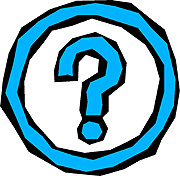CATALYTIC REACTIONS?
If you have a photo or other graphic that reflects an aspect of life (including laboratory life) or a quotation that scientists mightappreciate that would be fit to print in the space to the right, why not
send it to us via e-mail:
<catalyst@nih.gov>; fax: 402-4303; or mail: Building 2, Room 2E26.
Also, we
welcome "letters to the editor" for publication and your reactions
to anything on the Catalyst pages.
In Future Issues...
Talking to the Press
MRI Heart Imaging
NIH Databases Used Worldwide
 |
Kids' Catalyst: Volunteerism
To Stimulate the MindOn many of the buildings you see through the trees on the NIH Bethesda campus, experiments are taking place around the clock that aim to benefit humanity. Research protocols, found at this website,often need healthy volunteers for all different types of experiments. You could flex your ankle 100 times to study muscle movement, walk back and forth with sensors attached to you to study gait, or have neurotransmitters measured with an MRI.
But by far the most interesting study I’ve participated in was one run by Leonardo Cohen of NINDS, the National Institute of Neurological Diseases and Stroke. The aim of this study is to learn how to help stroke patients return to previous levels of functioning. Stroke victims may lose control of one side of their body, and it takes a lot of relearning to regain this control. Imagine having to learn how to write, or type, or even wave all over again! The study seeks to make this learning process faster and better—we don’t just want a motor-skills cram session that is forgotten in a week; we’re looking at lifelong learning.
So for three months, a member of Cohen’s team, Janine Reis, studied how I, and many others, learned.
An oversimplified version of the experiment (you can get the full protocol by going to the site mentioned above and typing NCT00314769 in the search box) is this: Stimulate the brain while performing a new a motor skill and see how quickly it is learned and how long it is remembered. What is the stimulation? It sounds like an old science fiction novel—transcranial direct current stimulation (tDCS) on a very specific part of the brain—but tDCS in the right place could do wonders.
It was like playing a video game—same motions, over and over. As with playing video games, I got better with practice. But how much better, and how quickly, and how long would I remember? Early findings suggest that those who receive stimulation learn faster, are more accurate, and keep the skill longer than those who do not. Maybe forever.
So if you decide to take the neurology path in your medical career, perhaps you’ll be one of the brilliant and dedicated minds studying the mind in the Clinical Center. I’ll be a happy test subject!
Or perhaps you, too, would get a kick out of being a healthy volunteer in a study like this one—just one example of the fascinating science that can be experienced firsthand at NIH, either as a volunteer or a researcher.
|
PUBLISHER EDITORS Henry
Metzger
|
MANAGING
EDITOR WRITER-
EDITOR COPY
EDITOR CONTRIBUTING
WRITER |
EDITORIAL
ADVISORY BOARD
|